Spatial Distribution Characteristics and Influencing Factors of Public Service Facilities for Children—A Case Study of the Central Urban Area of Shenyang
Abstract
1. Introduction
2. Materials and Methods
2.1. Study Area
2.2. Research Framework
2.3. Data Source and Processing
2.4. Methods
2.4.1. Methods for Analyzing Spatial Distribution of CPSFs
- (1)
- Quantity Distribution Characteristics
- (2)
- Diversity Distribution Characteristics
- (3)
- Spatial Equilibrium Characteristics
2.4.2. Methods for Analyzing Spatial Agglomeration Characteristics of CPSFs
2.4.3. Factor Selection for CPSF Spatial Distribution
2.4.4. Regression Analysis of CPSF Influencing Factors
3. Results
3.1. Spatial Distribution Characteristics of CPSFs
3.1.1. Spatial Distribution in the Quantity Distribution of CPSFs
3.1.2. Spatial Distribution of the Diversity Characteristics of CPSFs
3.1.3. Spatial Distribution of the Uneven Characteristics of CPSFs
3.2. Spatial Agglomeration Characteristics of CPSFs
3.3. Regression Analysis Results of Influencing Factors on CPSFs
4. Discussion
4.1. Spatial Distribution Differences of CPSFs
4.2. Spatial Heterogeneity of the Influencing Factors for CPSFs
4.3. Optimization Strategies for CPSF Spatial Layout
4.4. Research Contributions and Limitations
5. Conclusions
- (1)
- The spatial distribution of CPSFs exhibits significant disparities. In core urban areas, such as Huanggu District, Heping District, and Shenhe District, per unit area indices are notably high, whereas per capita indices are comparatively low. The per capita index for educational facilities is particularly low, indicating a demand gap. In old urban areas, such as Tiexi District, educational and recreational facilities are relatively sufficient, but cultural and sports facilities are scarce in quantity and diversity. In new urban areas, such as Hunnan District, facilities show high diversity with abundant cultural and sports resources, but medical and educational facilities are insufficient, and their supply lags behind population growth.
- (2)
- The Gini coefficients of all facility types are below the equity threshold of 0.4. However, the location entropy values across grid cells are unevenly distributed, with 90.32% of the study units recording values below 1, indicating imbalances between supply and demand.
- (3)
- All facility types demonstrate significant positive agglomeration characteristics. Educational facilities form a dual-core pattern in northern Tiexi District and southern Huanggu District. Health facilities cluster around core-area medical resources. Cultural, sports, and recreational facilities establish new agglomeration nodes in the eastern new district.
- (4)
- The spatial distribution of CPSFs is determined by five dimensions: population, transportation, economy, and environmental quality. Specifically, residential area density and commercial service facility density serve as primary positive drivers, whereas road density and average housing price act as key negative constraints. Moreover, the intensity of influencing factors varies across facility types. Educational facilities demonstrate additional dependence on the construction year of residential areas; healthcare facilities are significantly influenced by residential density; while cultural, sports, and recreational facilities exhibit strong correlations with both green space coverage and the night-time light index.
- (5)
- The impacts of influencing factors exhibit spatial heterogeneity. Positive drivers such as children’s population density significantly affect peripheral and new urban areas. Negative factors like building density show pronounced inhibitory effects in old urban areas. Threshold factors, including subway station density and public transport station density, demonstrate spatial divergence: inhibitory in old urban areas but positively promoting in peripheral and new urban areas.
Author Contributions
Funding
Data Availability Statement
Conflicts of Interest
Abbreviations
| CPSFs | Children’s Public Service Facilities |
| GWR | Geographically Weighted Regression |
| POI | Point-of-interest |
| SHDI | Shannon Diversity Index |
| LQ | Location Quotient |
| CPD | Child population density |
| GDP | Economic development |
| NTLI | Night-time light index |
| AHP | Average housing price |
| CSFD | Commercial service facility density |
| BSD | Bus stop density |
| MSD | Subway station density |
| RND | Road network density |
| ACYC | Average community completion year |
| BD | Building density |
| RAD | Residential area density |
| GSCR | Green space coverage rate |
References
- Jia, Y.; Chen, Z.; Lu, X.; Sheng, S.; Huang, J.; Wang, Y. The degradation and marginal effects of green space under the stress of urban sprawl in the metropolitan area. Urban For. Urban Green. 2024, 95, 128318. [Google Scholar] [CrossRef]
- Deng, B.X.; Zhong, F.L. Leading or Constraining? Development of New-Type Urbanization under Economic Growth Targets. Land 2023, 12, 916. [Google Scholar] [CrossRef]
- Jin, R. Exploring the association between the settlement environment and residents’ positive sentiments in urban villages and formal settlements in Shenzhen. Sustain. Cities Soc. 2023, 98, 104851. [Google Scholar] [CrossRef]
- Wang, W.; Wen, Y.; Chen, W.; Qu, Y. Spatial-Temporal Coupling Coordination Relationship between Urban Green Infrastructure Construction and Economic Development in China. Land 2024, 13, 1095. [Google Scholar] [CrossRef]
- Hao, J.; Ma, H. Spatial Heterogeneity of Public Service Facilities in the Living Circle and Its Influence on Housing Prices: A Case Study of Central Urban Dalian, China. Land 2022, 11, 1095. [Google Scholar] [CrossRef]
- Zhang, K.; Yan, D. Enhancing the Community Environment in Populous Residential Districts: Neighborhood Amenities and Residents’ Daily Needs. Sustainability 2023, 15, 13255. [Google Scholar] [CrossRef]
- Li, X.; Deng, Y.; Liu, B.; Yang, J.; Li, M.; Jing, W.; Chen, Z. GDP spatial differentiation in the perspective of urban functional zones. Cities 2024, 151, 105126. [Google Scholar] [CrossRef]
- Zheng, Q.; Jiang, G.; Tian, Y.; Meng, L.; Yang, L. Spatio-temporal pattern and allocation efficiency of public service land in rural settlements. Front. Environ. Sci. 2022, 10, 986417. [Google Scholar] [CrossRef]
- Guida, C.; Carpentieri, G.; Masoumi, H. Measuring spatial accessibility to urban services for older adults: An application to healthcare facilities in Milan. Eur. Transp. Res. Rev. 2022, 14, 1–13. [Google Scholar] [CrossRef]
- Statistics NBo. The communiqué of the 7th National Population Census 2020. Available online: https://www.stats.gov.cn/sj/tjgb/rkpcgb/qgrkpcgb/202302/t20230206_1902005.html (accessed on 20 May 2025).
- Jiang, J.; Wang, Z.; Yong, Z.; He, J.; Yang, Y.; Zhang, Y. Spatial Distribution and Accessibility Analysis of Primary School Facilities in Mega Cities: A Case Study of Chengdu. Sustainability 2024, 16, 723. [Google Scholar] [CrossRef]
- Xu, R.; Yue, W.; Wei, F.; Yang, G.; He, T.; Pan, K. Density pattern of functional facilities and its responses to urban development, especially in polycentric cities. Sustain. Cities Soc. 2022, 76, 103526. [Google Scholar] [CrossRef]
- Peng, J.; Liu, Y.; Ruan, Z.; Yang, H. Study on the optimal allocation of public service facilities from the perspective of living circle—A case study of Xiangyang High-tech Zone, China. J. Urban Manag. 2023, 12, 344–359. [Google Scholar] [CrossRef]
- Chen, X.; Zhang, Q.; Zhang, H. Disparities in the geospatial allocation of public facilities from the perspective of living circles. Open Geosci. 2024, 16, 20220654. [Google Scholar] [CrossRef]
- Qiu, Z.; Wang, Y.; Bao, L.; Yun, B.; Lu, J. Sustainability of Chinese Village Development in a New Perspective: Planning Principle of Rural Public Service Facilities Based on “Function-Space” Synergistic Mechanism. Sustainability 2022, 14, 8544. [Google Scholar] [CrossRef]
- Yang, H.; Chen, T.; Zeng, Z.; Mi, F. Does urban green space justly improve public health and well-being? A case study of Tianjin, a megacity in China. J. Clean. Prod. 2022, 380, 134920. [Google Scholar] [CrossRef]
- Chen, K.; Zhao, P.; Qin, K.; Kwan, M.-P.; Wang, N. Towards healthcare access equality: Understanding spatial accessibility to healthcare services for wheelchair users. Comput. Environ. Urban Syst. 2024, 108, 102069. [Google Scholar] [CrossRef]
- Li, X.; Yang, Z.; Guo, Y.; Xu, W.; Qian, X. Factoring in Temporal Variations of Public Transit-Based Healthcare Accessibility and Equity. Int. J. Transp. Sci. Technol. 2024, 13, 186–199. [Google Scholar] [CrossRef]
- Chan, H.-Y.; Xu, Y.; Chen, A.; Zhou, J. Choice and equity: A critical analysis of multi-modal public transport services. Transp. Policy 2023, 140, 114–127. [Google Scholar] [CrossRef]
- Li, H.N.; Li, L.; Li, Y.; Ji, Q.; Zhao, J.B.; Ge, Z.X.; Zhou, Q.; Sun, Q.; Murad, A. A research on spatial configuration characteristics and social performance evaluation of public sports facilities in shanghai based on geographic information system (GIS). PLoS ONE 2025, 20, e0310585. [Google Scholar] [CrossRef]
- Zhang, N.; Wang, S.H.; Liang, H.J.; Huang, Z.N.; Li, X.; Wang, Z.B. Heterogeneity Analysis of Resident Demands and Public Service Facilities in Megacities of China from the Perspective of Urban Health Examination. ISPRS Int. J. Geo-Inf. 2025, 14, 188. [Google Scholar] [CrossRef]
- Wang, P.Y.; Zhang, Q.; Li, Z.M.; Wang, F.; Shi, Y. Exploring a comprehensive evaluation model for measuring spatial equity in the layout of city community elderly service facilities: A case study in Xi’an, China. Open House Int. Sustain. Smart Archit. Urban Stud. 2024, 49, 791–817. [Google Scholar] [CrossRef]
- Zhang, S.; Xu, S.M.; Wan, D.; Liu, H.; Zhao, L.; Guo, L.; Ren, J. Equalization Measurement and Optimization of the Public Cultural Facilities Distribution in Tianjin Central Area. Sustainability 2023, 15, 4856. [Google Scholar] [CrossRef]
- Li, Z.; Bai, X.; Xu, Z.J.; Ma, H.Q.; Xu, Y.A.; Wang, N.; Yue, X. The optimal spatial delineation method for the service level of urban park green space from the perspective of opportunity equity. Environ. Sci. Pollut. Res. 2023, 30, 85520–85533. [Google Scholar] [CrossRef] [PubMed]
- Luo, W.C.; Chen, H.; Yang, Z.H.; Liu, J.H. Accessibility and Equity of Park Green Spaces: Considering Differences in Walking Speeds Across Age Groups. Land 2024, 13, 2240. [Google Scholar] [CrossRef]
- Chen, C. Discussion on the Optimization Method of Public Service Facility Layout from the Perspective of Spatial Equity: A Study Based on the Central City of Shanghai. Land 2023, 12, 1780. [Google Scholar] [CrossRef]
- Khumalo, K.B.Z. Urban Regeneration: Investigating the Effects of Urban Decay on Residents in the City of Pietermaritzburg, South Africa. Master’s Thesis, University of Johannesburg, Johannesburg, South Africa, 2023. [Google Scholar]
- Liu, T.; Deng, Q.; Wang, S.; Wang, G. Equity Evaluation of Multilevel Medical Facility Allocation Based on Ga2SFCA. J. Urban Plan. Dev. 2023, 149, 04023041. [Google Scholar] [CrossRef]
- Xiao, T.; Ding, T.F.; Zhang, X.K.; Tao, Z.L.; Liu, Y. Spatial Accessibility to Sports Facilities in Dongguan, China: A Multi-Preference Gaussian Two-Step Floating Catchment Area Method. Appl. Spat. Anal. Policy 2022, 15, 1093–1114. [Google Scholar] [CrossRef]
- Zhang, L.L.; Zhang, X.B.; Huang, H.L.; Zhang, L.; Li, H. Spatial Accessibility of Multiple Facilities for Affordable Housing Neighborhoods in Harbin, China. Land 2022, 11, 1940. [Google Scholar] [CrossRef]
- Cui, X.J.; Ma, L.B.; Tao, T.M.; Zhang, W.B. Do the supply of and demand for rural public service facilities match? Assessment based on the perspective of rural residents. Sustain. Cities Soc. 2022, 82, 103905. [Google Scholar] [CrossRef]
- Wang, H.C.; Chen, J.; Xu, K.B. Spatial Distribution and Territorial Justice of Public Service for Disadvantaged Groups: Evidence from China. Soc. Indic. Res. 2024, 172, 741–763. [Google Scholar] [CrossRef]
- Jin, M.J.; Deng, Q.T.; Wang, S.Y.; Wei, L.T. Equity Evaluation of Elderly-Care Institutions Based on Ga2SFCA: The Case Study of Jinan, China. Sustainability 2023, 15, 16943. [Google Scholar] [CrossRef]
- Chang, X.Y.; Ma, L.B.; Cui, X.J.; Tao, T.M.; Zhao, S.C. Spatial Equity Evaluation of Rural Eldercare Service Resources Based on Accessibility: A Case Study of Huanxian County of Gansu Province, China. Chin. Geogr. Sci. 2024, 34, 869–885. [Google Scholar] [CrossRef]
- Cheng, T.; Liu, C.H.; Yang, H.W.; Wang, N.; Liu, Y.S. From service capacity to spatial equity: Exploring a multi-stage decision-making approach for optimizing elderly-care facility distribution in the city centre of Tianjin, China. Sustain. Cities Soc. 2022, 85, 104076. [Google Scholar] [CrossRef]
- Wan, D.; Liu, H.; Guo, J.X.; Guo, L.; Qi, D.C.; Zhang, S.; Li, P.; Fukuda, H. Spatial Distribution and Accessibility Measurements for Elderly Day Care Centers in China’s Urban Built-up Area: The Case of Tianjin Nankai District. Buildings 2022, 12, 1413. [Google Scholar] [CrossRef]
- Zhu, P.J.; Huang, Q.J.; Wan, Y.L.; Zou, Z.J. Spatial differentiation of urban children’s public service facility allocation levels in China and their influencing factors. Econ. Geogr. 2023, 43, 55–67. [Google Scholar] [CrossRef]
- Wang, X.; Huang, J.P.; Qin, Z.Y.; Gan, W.; He, Z.; Li, X. Is the Children’s 15-Minute City an Effective Framework for Enhancing Children’s Health and Well-Being? An Empirical Analysis from Western China. Buildings 2025, 15, 248. [Google Scholar] [CrossRef]
- Seok, S.H.; Eun, K.J. An Influence of Child-welfare Facilities’ Social Workers’ Professionalism on the Human Rights Awareness. J. Humanit. Soc. Sci. 2017, 8, 603–620. [Google Scholar] [CrossRef]
- Liu, L.R.; Leslie, H.H.; Joshua, M.; Kruk, M.E. Exploring the association between sick child healthcare utilisation and health facility quality in Malawi: A cross-sectional study. BMJ Open 2019, 9, e029631. [Google Scholar] [CrossRef]
- Victor, C.; Kupoluyi, J.A.; Oyinlola, F.F.; Sule, V.O. Prevalence and factors associated with water, sanitation and hygiene (WASH) facilities deprivation among children in Nigeria. BMC Pediatr. 2025, 25, 1–16. [Google Scholar] [CrossRef]
- No, I.; Suk, Y.H. Investigation of the Teacher’s Perception and Adequacy of the Facilities in Childhood Institutions. J. Humanit. Soc. Sci. 2018, 9, 179–194. [Google Scholar] [CrossRef]
- Kim, H.; Kim, J.; Kim, S.; Eom, M. Facility rules of child-rearing facility from a child rights perspective: Focusing on child rearing facilities in Gyeonggi-do. J. Korean Counc. Child. Rights 2024, 28, 497–524. [Google Scholar] [CrossRef]
- Cantor, J.; McBain, R.K.; Kofner, A.; Stein, B.D.; Yu, H. Where are US outpatient mental health facilities that serve children with autism spectrum disorder? A national snapshot of geographic disparities. Autism 2022, 26, 169–177. [Google Scholar] [CrossRef] [PubMed]
- Euyhong, H.; Hanbit, C.; Donmook, C. A Study on Effective Fire Countermeasures for Facilities for the Elderly and Children. Fire Sci. Eng. 2020, 34, 107–114. [Google Scholar] [CrossRef]
- Guo, M.; Wang, S. Research on Urban Expansion and Population Density Change of an Urban Agglomeration in the Central-Southern Region of Liaoning Province, China. Complexity 2022, 2022, 5327023. [Google Scholar] [CrossRef]
- Wu, X.; Zhang, Y.; Wang, L. Coupling relationship between regional urban development and eco-environment: Inspiration from the old industrial base in Northeast China. Ecol. Indic. 2022, 142, 109259. [Google Scholar] [CrossRef]
- Özkan, S.; Ali, E. Building Child-Friendly Cities for Sustainable Child Development: Child-Friendly City Scale-Child Form. Sustainability 2024, 16, 1228. [Google Scholar] [CrossRef]
- Quan, Z.; Dali, M.B.M.; Zainol, R. A Review of Child-Friendly City Assessment Tools—Are We Really Planning Cities for Children? Int. J. Relig. 2024, 5, 621–637. [Google Scholar] [CrossRef]
- Yang, J.; Huang, X. The 30 m annual land cover dataset and its dynamics in China from 1990 to 2019. Earth Syst. Sci. Data 2021, 13, 3907–3925. [Google Scholar] [CrossRef]
- Chen, J.; Fu, Y.; Ma, S.; Chen, Q.; Zhang, W.; Huang, J. Research on the supply-demand balance evaluation and driving mechanism of community public service facilities. PLoS ONE 2025, 20, e0322109. [Google Scholar] [CrossRef]
- Zhang, J.; Hu, X.; Wang, J. Spatial vitality variation in community parks and their influencing factors. PLoS ONE 2025, 20, e0312941. [Google Scholar] [CrossRef]
- Yu, Q.; Zhang, T.; Jiang, L.; Jia, Y.; Dong, Y.; Luo, L. Equity analysis of older adult resource allocation in China. Front. Public Health 2024, 12, 1411054. [Google Scholar] [CrossRef]
- Lee, K.S.; Eom, J.K. Spatiotemporal dynamics of visitors to Jeju Island: Hotspot and spatial autocorrelation analyses using mobile phone data. PLoS ONE 2025, 20, e0321694. [Google Scholar] [CrossRef] [PubMed]
- Yang, J.X.; Chen, M.Z. Assessing the impact of urban amenities on people with disabilities in London: A multiscale geographically weighted regression analysis. Habitat Int. 2025, 161, 103426. [Google Scholar] [CrossRef]
- Chen, Y.; He, S.Y.; Zhang, M.M.; Cai, Y. Resident demand-oriented selection and spatial layout strategy for public sports facilities. Proc. Inst. Civ. Eng.-Munic. Eng. 2024, 177, 130–143. [Google Scholar] [CrossRef]
- Chen, Y.B.; Zhang, Z.L.; Lang, L.X.; Long, Z.; Wang, N.F.; Chen, X.P.; Wang, B.; Li, Y. Measuring the Spatial Match between Service Facilities and Population Distribution: Case of Lanzhou. Land 2023, 12, 1549. [Google Scholar] [CrossRef]
- Zhou, E.B.; Murray, A.T. Facility Layout and Spatial Configuration Efficiency Assessment. Netw. Spat. Econ. 2024, 24, 1–25. [Google Scholar] [CrossRef]
- Fu, Y.; Wang, S.Y. Constructing an evaluation framework for child-friendly city: A case study of outdoor recreation spaces in Shenyang City, China. J. Asian Archit. Build. Eng. 2025, 24, 1–22. [Google Scholar] [CrossRef]
- Long, Y.; Ao, Y.B.; Li, H.M.; Bahmani, H.; Li, M.Y. Non-linear effects of children’s daily travel distance on their travel mode choice considering different destinations. J. Transp. Geogr. 2024, 118, 103921. [Google Scholar] [CrossRef]
- Fang, K.L.; Azizan, S.A.; Huang, H.M. GIS-based intelligent planning approach of child-friendly pedestrian pathway to promote a child-friendly city. Sci. Rep. 2024, 14, 8139. [Google Scholar] [CrossRef]
- Liu, W.; Wang, W. A Study on the Assessment of Tour-Art-Learning Quality in Urban Parks from a Child-Friendly Perspective: A Case Study of Shaheyuan Park in Chengdu. Sustainability 2025, 17, 684. [Google Scholar] [CrossRef]


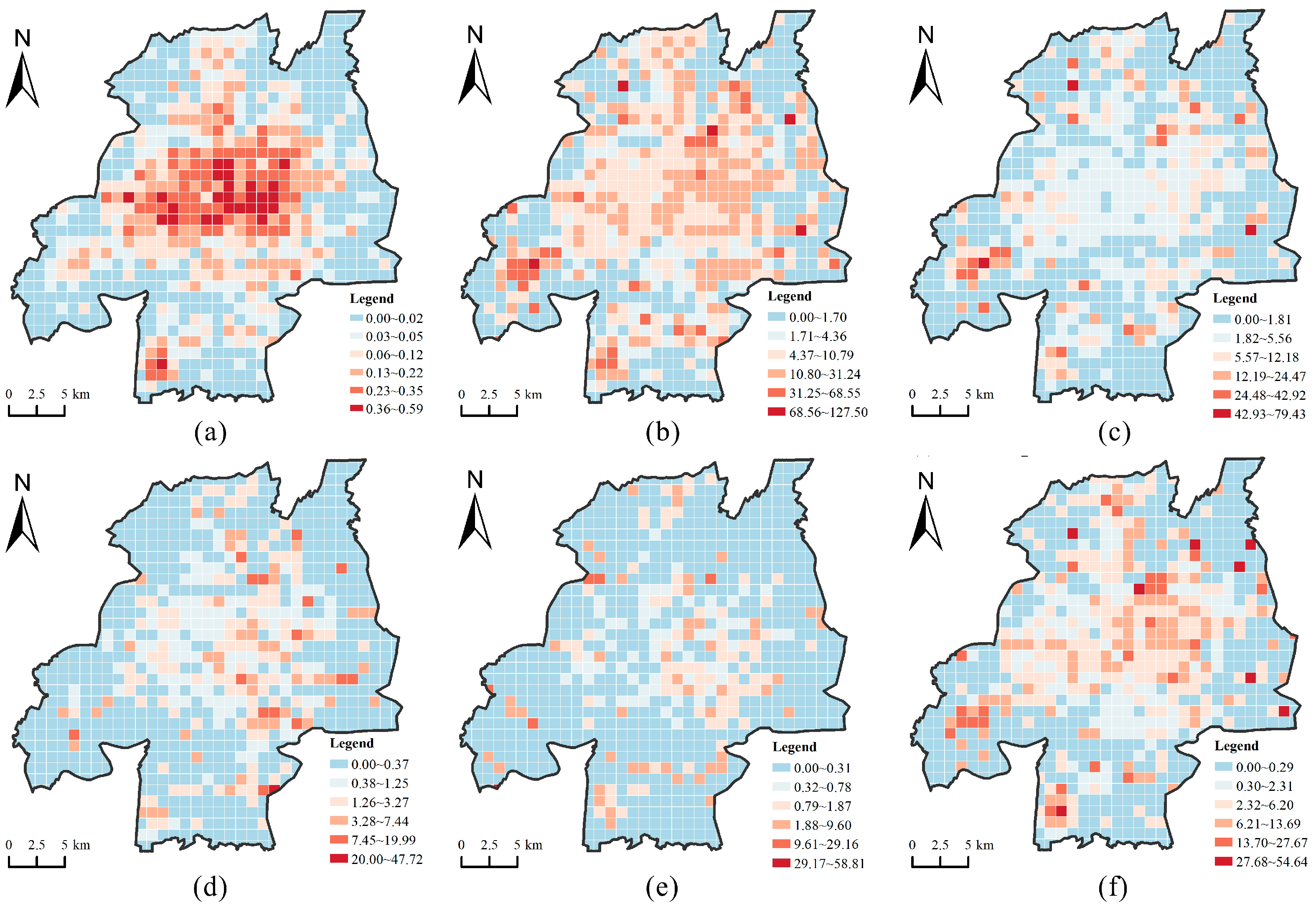
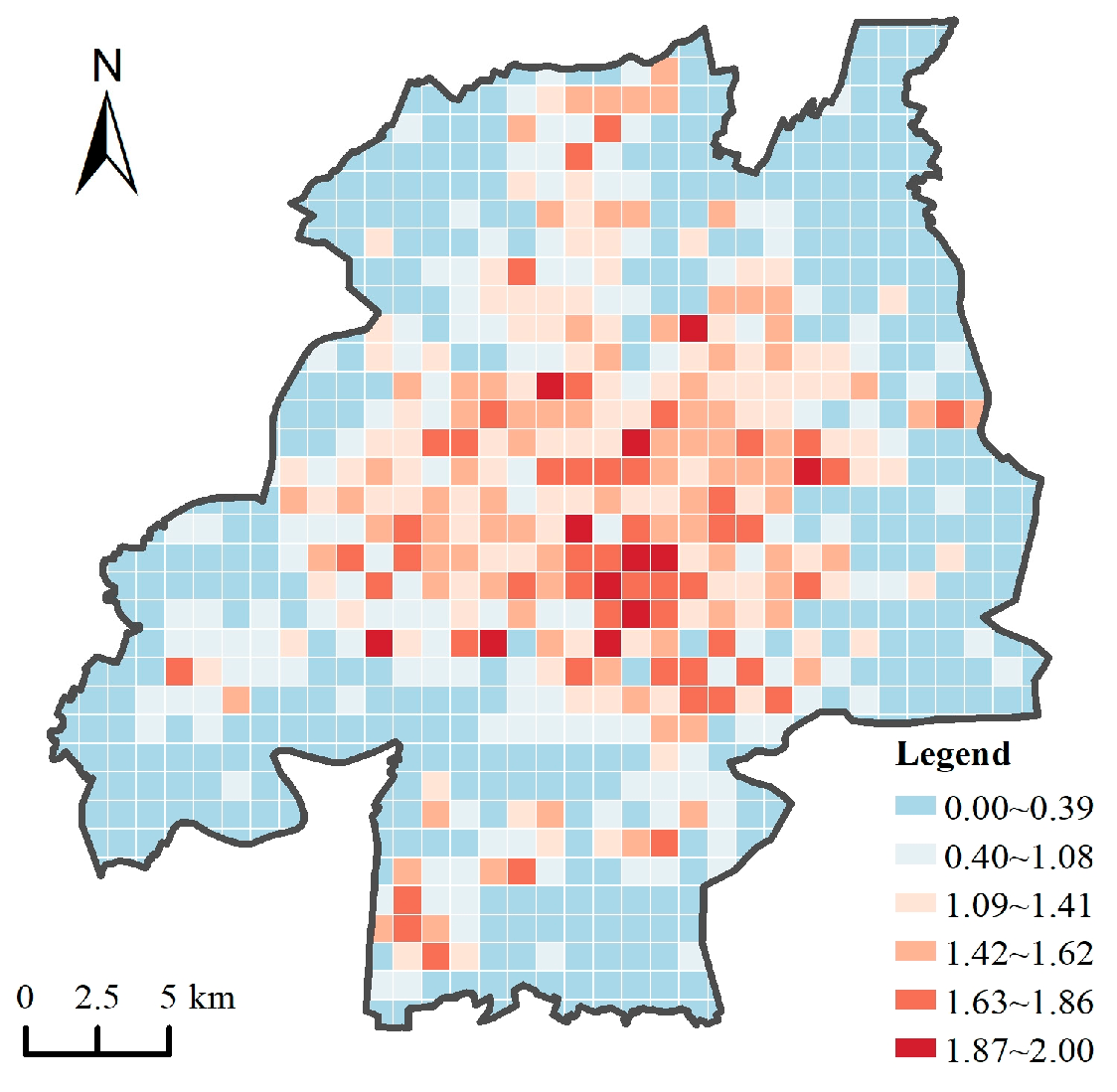
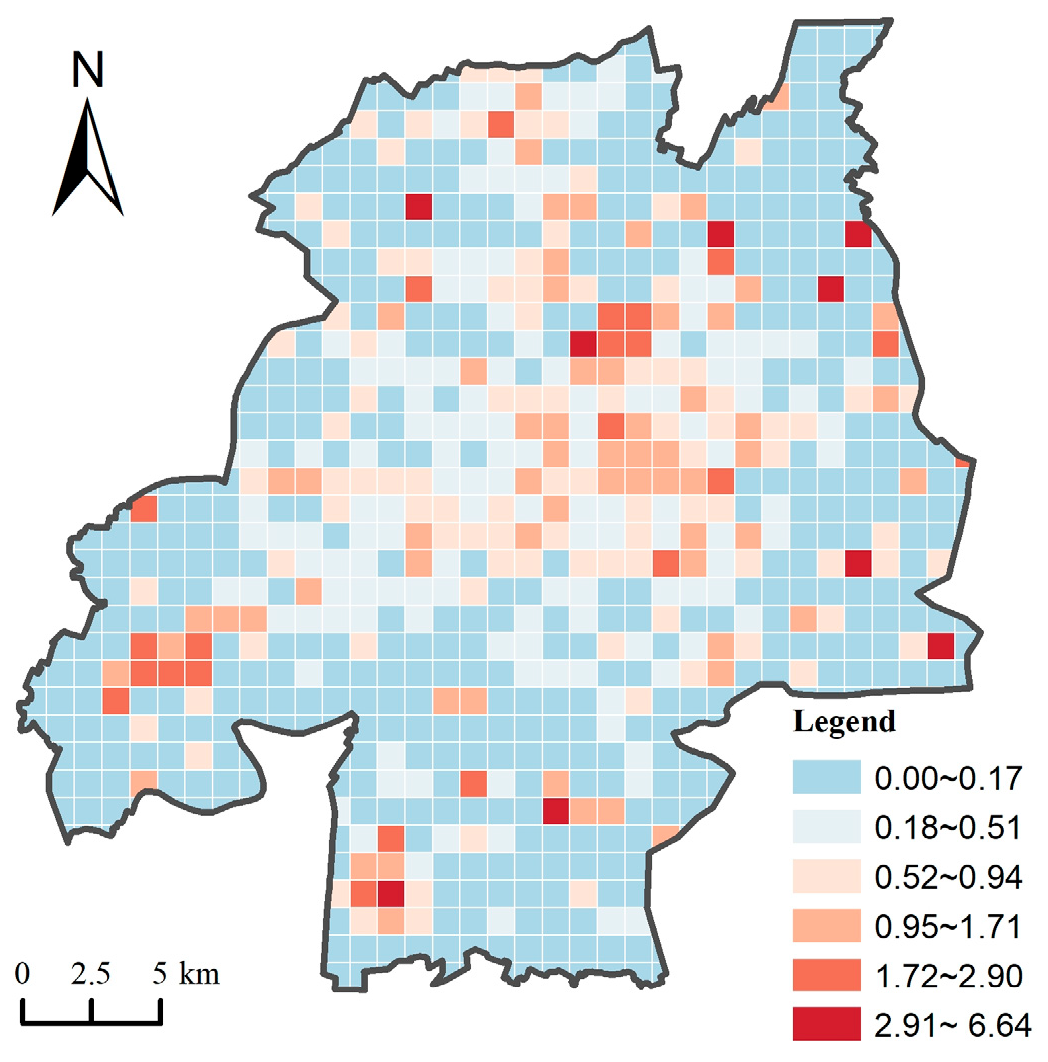
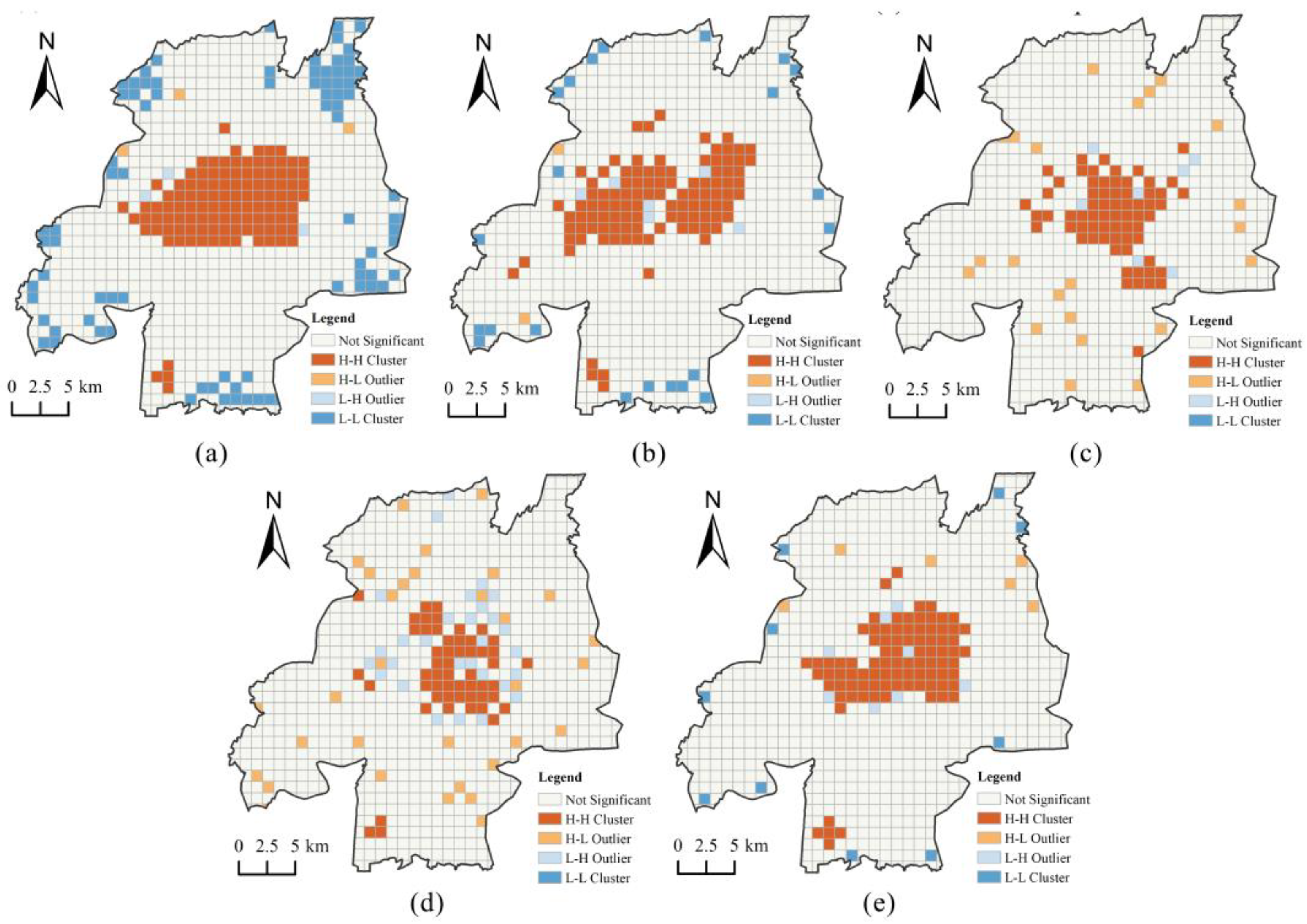

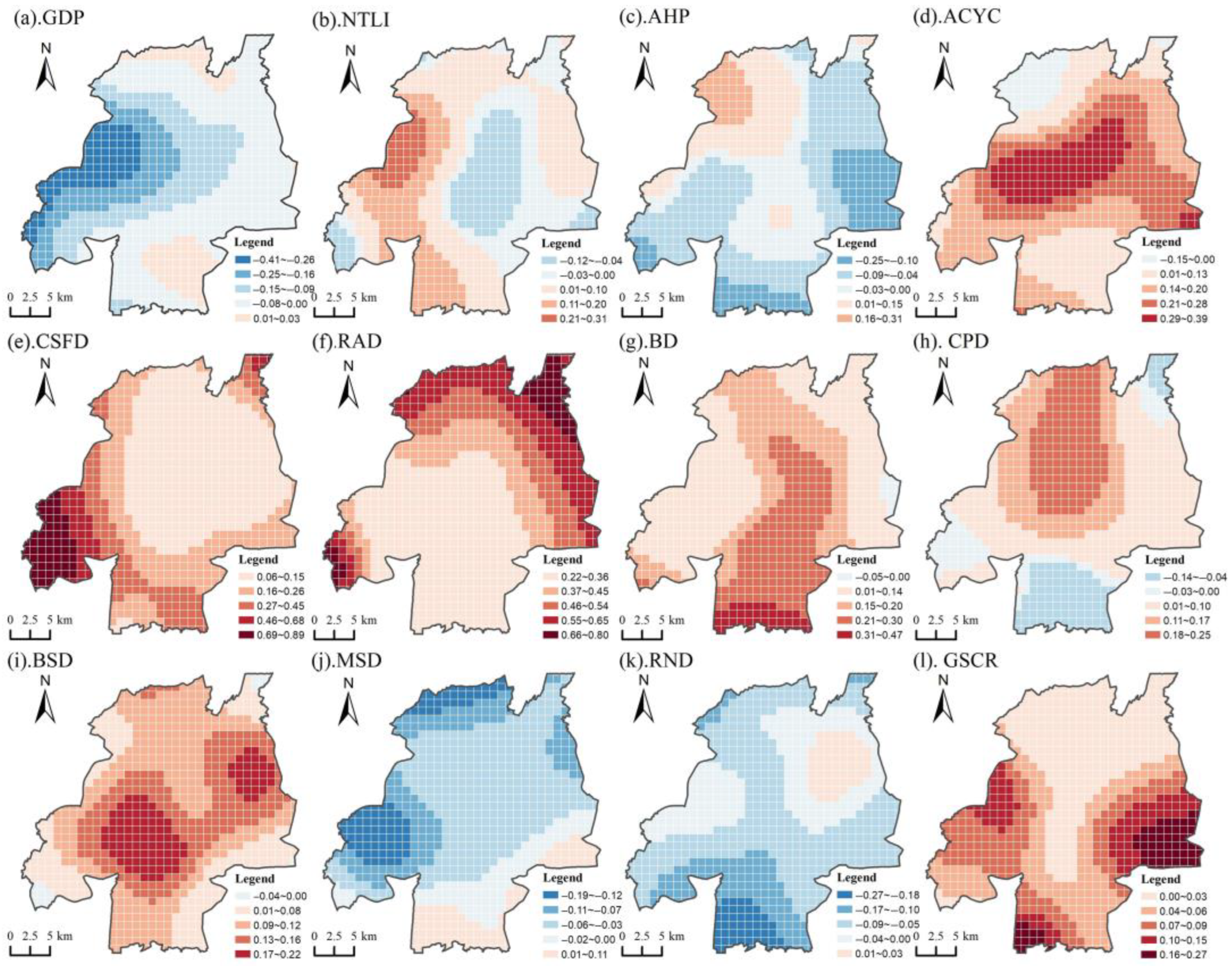

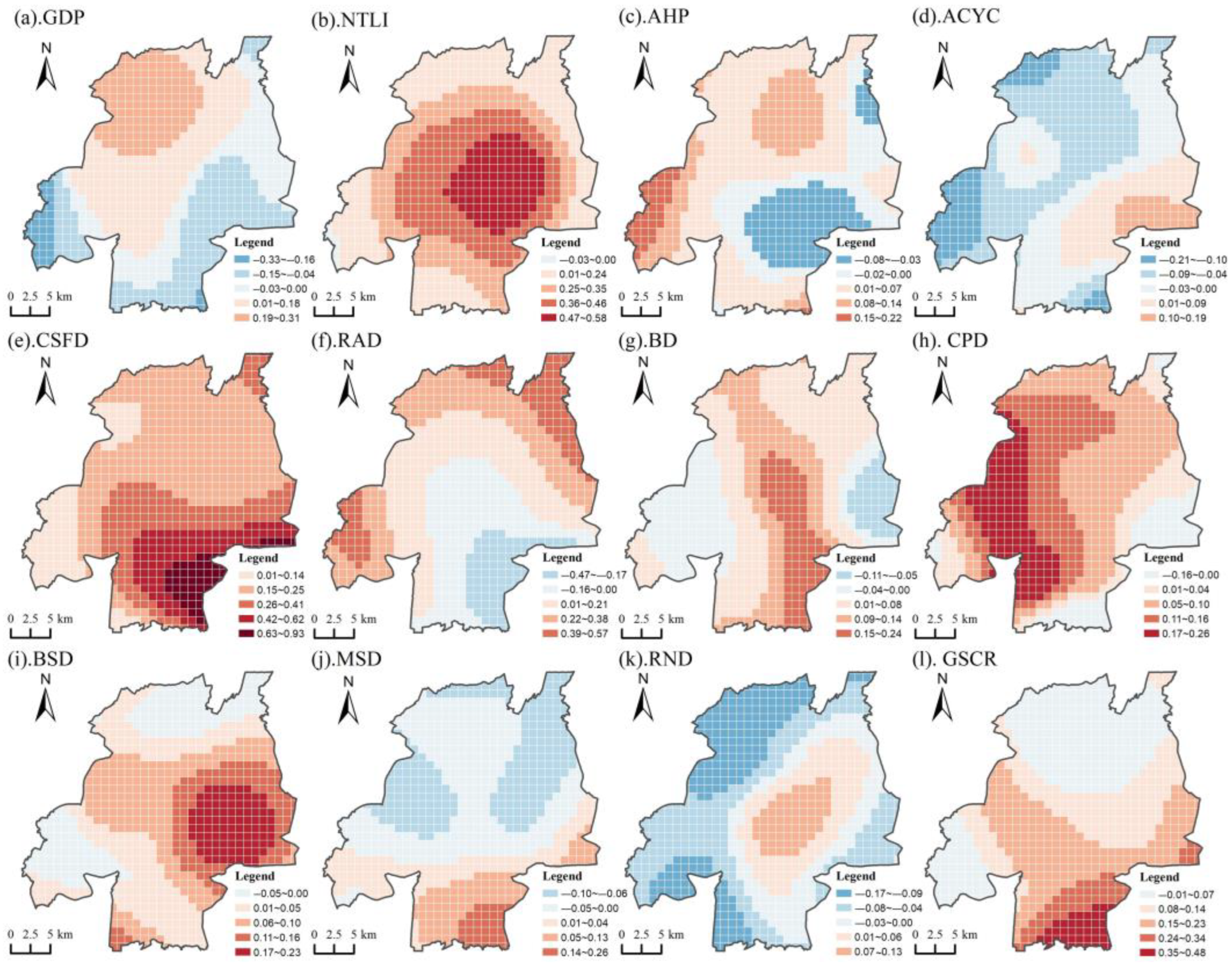
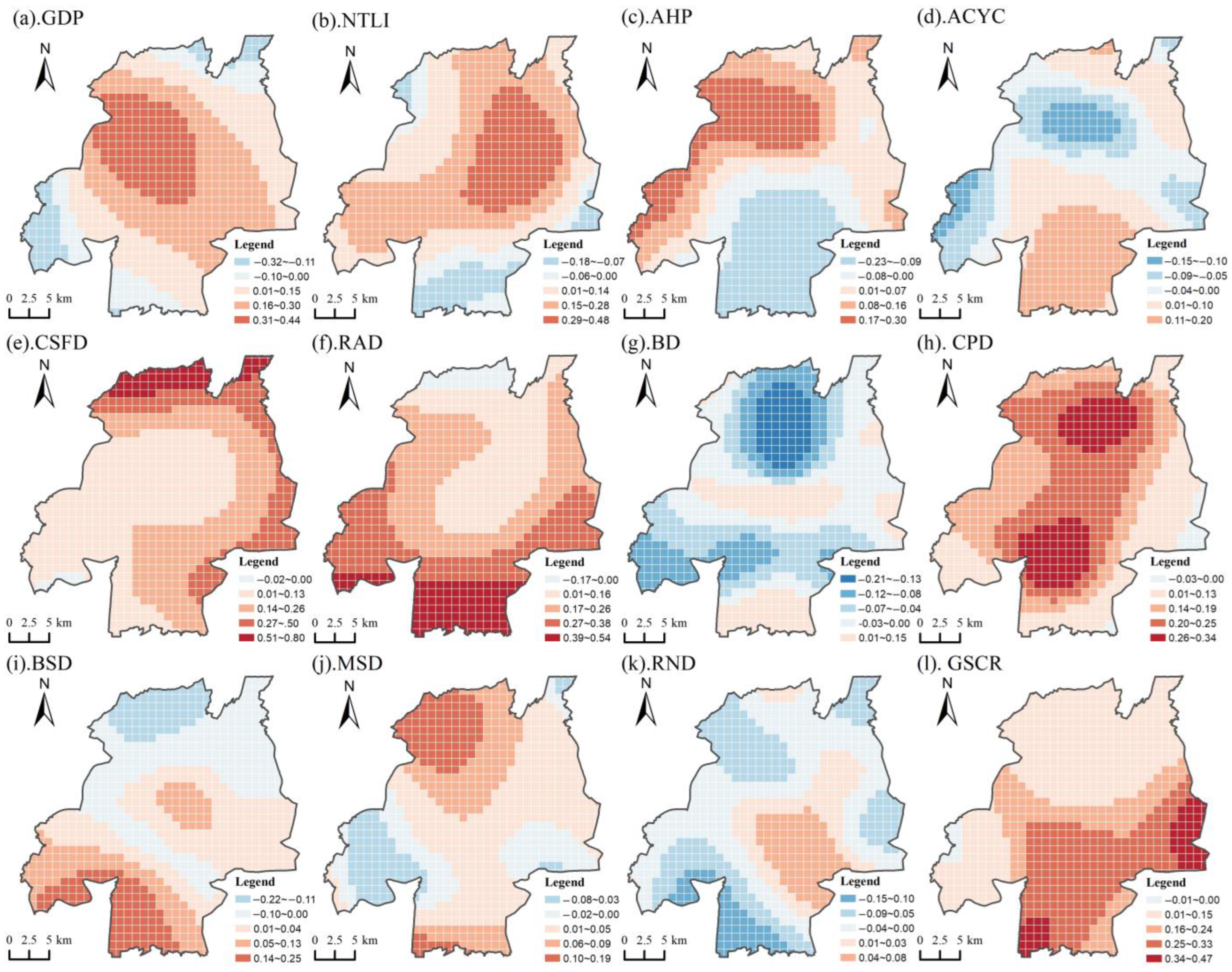
| Dimension | Variable | Abbreviation | Description |
|---|---|---|---|
| Population characteristics | Child population density | CPD | Reflects the spatial distribution density of children, which is the basis for planning CPSFs. |
| Economic development | GDP | GDP | Reflects the overall scale and level of regional economic development and measures the local government’s financial capacity to invest in CPSFs. |
| Night-time light index | NTLI | Indirectly reflects the real-time economic activity level through the intensity of surface night lighting. | |
| Average housing price | AHP | Reflects the regional land value and residents’ consumption capacity. | |
| commercial service facility density | CSFD | Measures the distribution density of commercial facilities, representing the regional economic vitality and service supply capacity. | |
| Transportation accessibility | Bus stop density | BSD | Quantifies the spatial coverage of public transport services, reflecting the convenience for children to use CPSFs. |
| Subway station density | MSD | Measures the coverage of rapid rail transit, affecting the convenience of children using children’s facilities over long distances. | |
| Road network density | RND | Statistics on the ratio of the total road length to the regional area, a key parameter for assessing transport infrastructure completeness. | |
| Environment quality | Average community completion year | ACYC | Reflects the community renewal degree through the age of buildings (newer communities often have more complete children’s facilities). |
| Building density | BD | Calculates the proportion of building area to land area, reflecting the intensity of spatial development. | |
| Residential area density | RAD | Reflects the spatial agglomeration degree of residential land. | |
| Green space coverage rate | GSCR | Measures the proportion of public green space area, an important basis for assessing the quality of children’s outdoor activity environment. |
| Facility Type | Moran’s I Value | Z-Score |
|---|---|---|
| Educational Facilities | 0.5884 | 23.2133 |
| Health Facilities | 0.65 i | 25.9134 |
| Cultural and Sports Facilities | 0.4758 | 18.8949 |
| Recreational Facilities | 0.3532 | 14.0905 |
| Overall Facilities | 0.7568 | 29.8452 |
| Statistics | Parameters |
|---|---|
| Bandwidth | 6127.0680 |
| Residual Squares | 80.9364 |
| Sigma | 0.3344 |
| AICc | 605.5218 |
| R2 | 0.9033 |
| R2 Adjusted | 0.8883 |
| Variable | Min | Q1 | Median | Q3 | Max | Mean | Std. Dev. |
|---|---|---|---|---|---|---|---|
| GDP | −0.0862 | −0.0265 | 0.0003 | 0.0224 | 0.0497 | −0.0038 | 0.0322 |
| NTLI | −0.3000 | 0.0686 | 0.1020 | 0.1449 | 0.2082 | 0.1020 | 0.0503 |
| AHP | −0.3163 | −0.1085 | −0.0789 | −0.0483 | 0.0676 | −0.0720 | 0.0599 |
| ACYC | −0.0300 | 0.0568 | 0.1029 | 0.1469 | 0.2546 | 0.1012 | 0.0665 |
| CSFD | 0.1233 | 0.2084 | 0.2875 | 0.3737 | 0.6710 | 0.3103 | 0.1310 |
| RAD | 0.1579 | −0.3372 | 0.4085 | 0.4885 | 0.6539 | 0.4238 | 0.1040 |
| BD | 0.0112 | 0.0642 | 0.0903 | 0.1766 | 0.3054 | 0.1160 | 0.0714 |
| CPD | −0.2517 | 0.0319 | 0.0749 | 0.1147 | 0.18843 | 0.0650 | 0.0725 |
| BSD | −0.0218 | 0.0380 | 0.0719 | 0.1076 | 0.1482 | 0.0721 | 0.0397 |
| MSD | −0.1080 | −0.0635 | −0.0445 | −0.0168 | 0.1447 | −0.0384 | 0.0383 |
| RND | −0.1071 | −0.0404 | −0.0160 | 0.0177 | 0.0903 | −0.0085 | 0.0447 |
| GSCR | −0.0372 | 0.0427 | 0.0678 | 0.0992 | 0.3556 | 0.0753 | 0.0493 |
| Variables | Education | Culture and Sports | Leisure and Recreation | Safety and Health | ||||
|---|---|---|---|---|---|---|---|---|
| Median | Mean | Median | Mean | Median | Mean | Median | Mean | |
| GDP | −0.0726 | −0.1019 | −0.0080 | 0.0275 | 0.1419 | 0.1280 | −0.0012 | 0.0002 |
| NTLI | 0.0161 | 0.0379 | 0.2908 | 0.2875 | 0.1457 | 0.1359 | 0.0574 | 0.0613 |
| AHP | −0.0473 | −0.0308 | 0.0235 | 0.0314 | 0.0385 | 0.0363 | −0.0817 | −0.0736 |
| ACYC | 0.1606 | 0.1651 | −0.0412 | −0.0338 | −0.0056 | 0.0106 | 0.0226 | 0.0199 |
| CSFD | 0.1682 | 0.2463 | 0.2121 | 0.2774 | 0.1472 | 0.1975 | 0.2985 | 0.2974 |
| RAD | 0.3871 | 0.4381 | 0.1276 | 0.1254 | 0.2184 | 0.2307 | 0.4540 | 0.4680 |
| BD | 0.1445 | 0.1524 | 0.0532 | 0.0526 | −0.0340 | −0.0410 | 0.0297 | 0.0510 |
| CPD | 0.0568 | 0.0668 | 0.0869 | 0.0827 | 0.1760 | 0.1648 | 0.0720 | 0.0776 |
| BSD | 0.1084 | 0.1047 | 0.0479 | 0.0602 | 0.0122 | 0.0142 | 0.0358 | 0.0358 |
| MSD | −0.0585 | −0.0584 | −0.0344 | −0.0137 | 0.0246 | 0.0313 | −0.0364 | −0.0244 |
| RND | −0.0661 | −0.0717 | −0.0549 | −0.0430 | −0.0286 | −0.0292 | −0.0359 | −0.0108 |
| GSCR | 0.0417 | 0.0572 | 0.1037 | 0.1288 | 0.1609 | 0.1723 | 0.0685 | 0.0631 |
Disclaimer/Publisher’s Note: The statements, opinions and data contained in all publications are solely those of the individual author(s) and contributor(s) and not of MDPI and/or the editor(s). MDPI and/or the editor(s) disclaim responsibility for any injury to people or property resulting from any ideas, methods, instructions or products referred to in the content. |
© 2025 by the authors. Licensee MDPI, Basel, Switzerland. This article is an open access article distributed under the terms and conditions of the Creative Commons Attribution (CC BY) license (https://creativecommons.org/licenses/by/4.0/).
Share and Cite
Pang, R.; Xiao, J.; Yang, J.; Sun, W. Spatial Distribution Characteristics and Influencing Factors of Public Service Facilities for Children—A Case Study of the Central Urban Area of Shenyang. Land 2025, 14, 1485. https://doi.org/10.3390/land14071485
Pang R, Xiao J, Yang J, Sun W. Spatial Distribution Characteristics and Influencing Factors of Public Service Facilities for Children—A Case Study of the Central Urban Area of Shenyang. Land. 2025; 14(7):1485. https://doi.org/10.3390/land14071485
Chicago/Turabian StylePang, Ruiqiu, Jiawei Xiao, Jun Yang, and Weisong Sun. 2025. "Spatial Distribution Characteristics and Influencing Factors of Public Service Facilities for Children—A Case Study of the Central Urban Area of Shenyang" Land 14, no. 7: 1485. https://doi.org/10.3390/land14071485
APA StylePang, R., Xiao, J., Yang, J., & Sun, W. (2025). Spatial Distribution Characteristics and Influencing Factors of Public Service Facilities for Children—A Case Study of the Central Urban Area of Shenyang. Land, 14(7), 1485. https://doi.org/10.3390/land14071485







